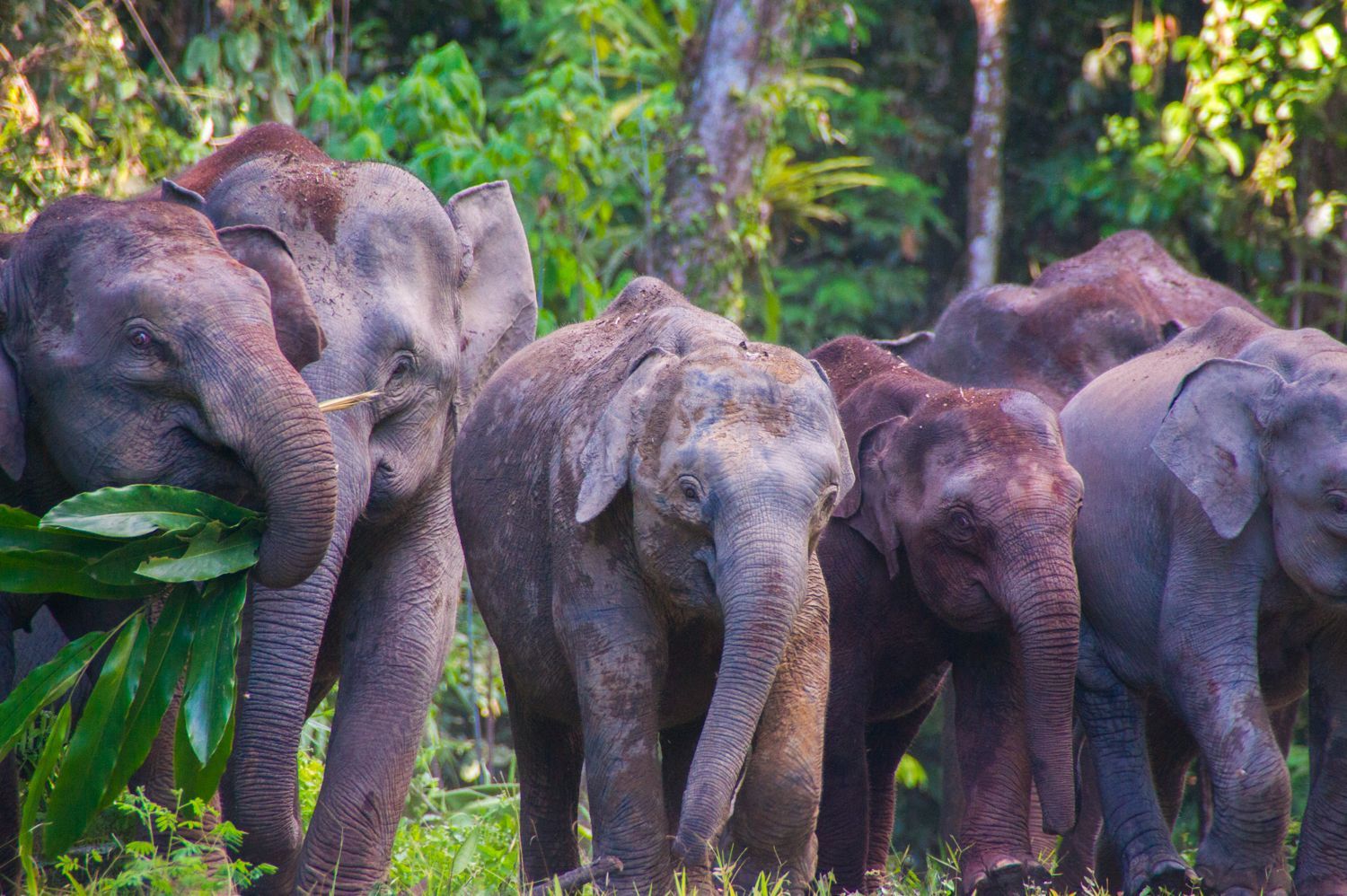
The Secret of Borneo Pygmy Elephants
Written by Aleena Che Ramli
On the island of Borneo, live pygmies of elephants where the origin remain a mystery. Known as the Bornean pygmy elephant or Elephas maximus borneensis, recognised as the smallest elephant in the world, inhabiting on a small patch of the earth, which is in the tropical rainforest of Sabah in Malaysia and deep inside the forest of north Kalimantan in Indonesia. It is estimated that they are only 1500 Bornean pygmy elephants left in the wild, with populations mostly concentrated in the northeast region of Borneo in Sabah.
The Bornean pygmy elephant is classified as one of the 4 Asian elephant subspecies, which are genetically different from the rest of Asian elephants. These differences are shown both physically and in their behaviour. Bornean pygmy elephants are smaller than other Asian elephants, only growing up to 2.5 metres high rather than the 3.5 metres heights of their larger cousins. While, the appearance are more rotund with larger ears, a long tails that may brush the ground as they walk and mainly distinguishable by their shorter straighter tusk. Despite their bulky stature, they are agile creatures capable of running up to 26 miles per hour, just short of the fastest human speed ever recorded. Moreover, the Bornean pygmy elephant’s babyish looks makes them very endearing, known to be gentler and less aggressive than their mainland Asian and African cousins. But above all, pygmy elephants are most easily distinguish by geography, like many species on the island, only at the particular part of Borneo that the gentle giant can be found in the wild.
Borneo is a massive island separated from mainland Asia by the South China Sea, to which 3 nation are located, Malaysia, Indonesia and Brunei. The origin of the pygmy elephants on this island is still a subject to debate. It was once believed that Borneo’s elephants descended from a pair given to the Sultan of Sulu, who rule over present day Sabah in the 18th century by the East India company. And later were subsequently released into the Borneo rainforest. However, in 2003, some scientific evidence suggest that the elephants simply walk into Borneo when it was connected to continental Asia during the last ice age. They have been evolving independently of their cousins for the past 300 000 years. Five years later, another study suggested the elephants are actually more recent arrivals. According to this theory, the Bornean pygmy elephants are the descendants of the recent extinct Javan elephants from Indonesian island of Java. By establishing this wild population in Borneo, the Sultan of Sulu unintentionally save the Javan lineage.
Like human too, Bornean pygmy elephants are social mammals, living in matriarchal groups between 8 to 12 individuals. The family group will consist of an older matriarch, her daughters and their calves. The males usually stay with their mother and the herd until they reach adolescence at around 8 years old, before they move off to a different family group. Bornean pygmy elephants can live up to 60 years in the wild and the females can only give birth to one calf at a time for every 4 to 6 years. Although, this period may be prolonged if conditions are not appropriate for calves, such as during times of drought.
Since the Bornean pygmy elephants are herbivorous, they eat palms, grasses leaves and fruits in order to survive. They need a large area of natural habitat as individuals can travel up to 300 sq km annually. However, due to human population growth and the demand for agricultural land, the elephants’ habitat is becoming ever smaller. The main threats to Bornean pygmy elephant populations in Sabah include habitat loss, habitat fragmentation, low genetic diversity and illegal killing. Between 2010 and 2017, a team of researchers has fitted the elephants with GPS collars and discovered that the elephants actively avoided urbanised area such as roads and villages, and move quickly and directly towards areas with more vegetations. Nowadays, populations are no longer able to travel along their traditional migration roots and the subpopulations are no longer able to breed to maintain the genetic diversity. In 2010, there were only 2030 elephants recorded living in the wild. The current population was believed to decrease to around 1500 individuals, which was classed as critically endangered in the IUCN red list in 2013.
For the past 100 years, the range of wild elephants in Sabah and Kalimantan seems to have expanded very poorly despite access to suitable habitat elsewhere around Borneo. Based on researched, Borneo’s soil tends to be young, leached and infertile and there is speculation that the distribution of Bornean pygmy elephants on the island may be confined by the occurrence of natural mineral. As a result, you can only see them in certain particular areas, but not everywhere in Borneo. Pygmy elephants are generally found in lowland rainforest and river valleys. Family groups usually stay on flat land, so it is easy for calves to move around. In contrast, solitary adult males are known to travel to hill forest. Hence, degraded forest are an important habitat for the Bornean pygmy elephants. Instead of converting the forest to agricultural land, protecting it will be an important conservation strategy to ensure the future survival of these pygmy elephants.
How you can help? Sustainable ecotourism is proving to be a powerful tool for stimulating local economies and empowering local people to protect wildlife, rather than resorting to short-sighted exploitations such as poaching and deforestation. Quite simply, ecotourism motivates people to ensure that wildlife remain healthy and alive. So, your part is to travel to these destinations and marvel at wonders of nature and wildlife. Show your support, and your trip will give an impact more than you realised.
Seeing pygmy elephants of Borneo is a rare treat. But, there are 4 best spots identified as the pygmy’s migratory routes in Sabah, where you’ll most probably get to Catch a glimpse of these endangered species in the wild.
Kinabatangan River
Just 2 hours from Sandakan, Experience a highly recommended safari cruise along the longest river in Sabah. Known as “Corridor of Life”, multitude of animals can be seen just from your boat. Kinabatangan region hosts some of the most eclectic and rare wildlife in Borneo, including the highest population of orang utans and it’s the best place to find a family of Bornean pygmy elephant bathing and playing along the banks. The location is quite popular among naturalist and photographers, as crowd of people can be seen coming here all year round. For more surprises, book for the night cruise to watch mysterious nocturnal animals come alive and take this opportunity to get a closer look at some of the Bornean birds sleeping, perched on the trees.
Danum Valley
Classified as one of the last patch of the oldest and untouched primary rainforest for over 130 million years, Danum Valley is always on the bucket list of the nature and wildlife enthusiast. Here, travellers can explore a handful of jungle trails and discover wide array of wildlife from the canopy walkway with multiple viewing platforms spanning approximately 300 metres in length and stands at 26 metres at the highest. After Kinabatangan river, Danum Valley is pygmy elephant’s next favourite destination where they feel safe without any human wildlife conflicts. If they are in the area, there is a good chance of spotting small herds feeding in the secondary forest along the road to the Danum Valley Field Centre. Click here To read more about one of our traveller’s elephant encounter during their Silam-Taliwas-Danum Valley ride.
Tabin Wildlife Reserve
Situated in Lahad Datu, Tabin Wildlife Reserve is the largest wildlife reserve in Sabah establish since 1984. This incredible natural area is home to some of Borneo’s most iconic species namely Tembadau, orang utan, clouded leopard and all 8 species of Bornean hornbills, as well as the Bornean pygmy elephants which are often seen across the river from the Tabin Wildlife Resort. One of the important features of Tabin is the mud volcanoes that serve as mineral salt licks to the wildlife, has attract the animals especially the pygmy elephants to this area. After returning from your jungle trekking, relax your muscles with a soothing foot soak made from natural blend of herbs at the jungle resort.
Deramakot Forest Reserve
Deramakot Forest Reserve is rich in wildlife with 75 percent of Sabah’s mammal species can be found within its 55,507 hectares of mixed dipterocarp forest reserve. Wildlife found at the reserve includes iconic species such as Bornean pygmy elephant, orang utan, Proboscis monkeys, Banteng and clouded leopard. With such rich wildlife,, it may come as a surprise to note that Deramakot is logging concession where reduce impact logging is practiced. Most of the elephants are drawn to the reserve due to the abundance of fruit trees which were retained during the logging. And, the logged area are given 40 years to restore, before it can be log again.
